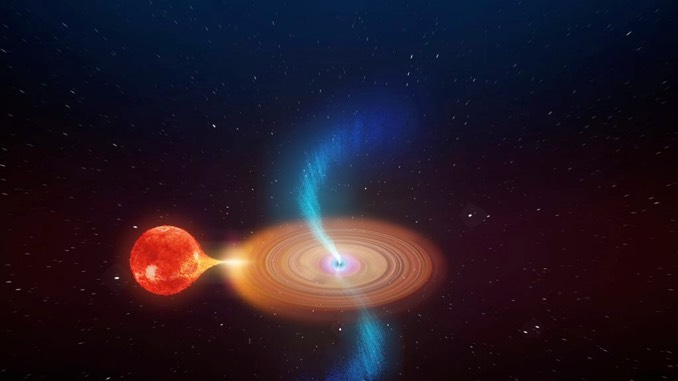
V404 Cygni is made up of a binary star system in which a central black hole is pulling material from a nearby star that then spirals inward forming a broad 10-million-kilometre-wide accretion disc. That’s not unusual. But jets flashing away from the poles of V404 Cygni’s black hole appear to be firing off in different directions in periods as short as a few minutes as the spinning hole’s powerful gravity drags nearby space along with it.
“This is one of the most extraordinary black hole systems I’ve ever come across,” said James Miller-Jones, a researcher at the Curtin University node of the International Centre for Radio Astronomy Research (ICRAR). “Like many black holes, it’s feeding on a nearby star, pulling gas away from the star and forming a disk of material that encircles the black hole and spirals towards it under gravity.
“What’s different in V404 Cygni is that we think the disk of material and the black hole are misaligned. This appears to be causing the inner part of the disk to wobble like a spinning top and fire jets out in different directions as it changes orientation.”

V404 Cygni, nearly 8,000 light years away from Earth, was identified as a black hole in 1989 when astronomers noted an outburst of jets and radiation. Archival photographs showed earlier eruptions in 1938 and 1956. Another outburst was observed in 2015, prompting astronomers around the world to study the system in detail.
“Everybody jumped on the outburst with whatever telescopes they could throw at it,” Miller-Jones said. “So we have this amazing observational coverage.”
His team, using the Very Long Baseline Array radio telescope, found that instead of shooting straight away from the poles of the black hole, the jets shot out in different directions on timescales as short as a minutes. A detailed analysis indicated the accretion disc is not aligned with the hole’s rotation.
That causes relativistic “frame dragging” that warps the inner regions of the disc and pulls it around as the hole rotates, changing the orientation of the jets.
Black Hole’s Tug on Space Pulls Fast-Moving Jets in Rapid Wobble
“The inner part of the accretion disk was precessing and effectively pulling the jets around with it,” he said. “You can think of it like the wobble of a spinning top as it slows down — only in this case, the wobble is caused by Einstein’s theory of general relativity.”
Study co-author Gemma Anderson, also with ICRAR’s Curtin University node, said the observed wobble should not be unique to black hole binary systems.
“Anytime you get a misalignment between the spin of a black hole and the material falling in, you would expect to see this when a black hole starts feeding very rapidly,” Anderson said. “That could include a whole bunch of other bright, explosive events in the universe, such as supermassive black holes feeding very quickly or tidal disruption events, when a black hole shreds a star.”



